Author: Lucio Chachamovich

-
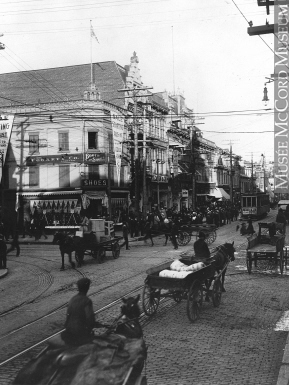 St. Lawrence Main and St. Catherine Street, Montreal, about 1905. Purchase from Mr. John N. Mappin. MP-1978.207.1.22Photo Credit : © McCord Museum, Montréal
St. Lawrence Main and St. Catherine Street, Montreal, about 1905. Purchase from Mr. John N. Mappin. MP-1978.207.1.22Photo Credit : © McCord Museum, Montréal
The Main
If there is one place in particular that is associated with the history of the Montreal Jewish community, it is undoubtedly Saint Laurent Boulevard.
Also known as “the Main,” St. Laurent Boulevard has been one of the city’s most iconic arteries since the turn of the 18th century. For more than a hundred years, it has been the centre of immigrant populations, particularly the life of the Jewish community. Jews first started settling in this area quite early in Montreal history.
By the turn of the 20th century, numerous synagogues, community centres and kosher restaurants were cropping up along the Main, which prompted the opening of several Yiddish theatres and cinemas. Saint Laurent Boulevard was also the location of most garment factories – where many Jewish workers were employed – not to mention the home of the Montreal Yiddish newspaper Keneder Adler (Canadian Eagle). For almost a half a century, Yiddish was the most common language on Saint Laurent Boulevard, and the third most spoken language in Montreal, after French and English.
Several famous Jews were raised in this neighbourhood, or lived there during their careers, including writer Mordecai Richler, singer and songwriter Leonard Cohen, and union organizer Léa Roback. As time progressed, the Jewish population of Montreal moved towards the west of the city.
Few remnants of their history remain on Saint Laurent Boulevard today. Nonetheless, most people feel that the Main retains a distinctive Jewish character, probably because it is home to the city’s most famous smoked meat and bagels.

-
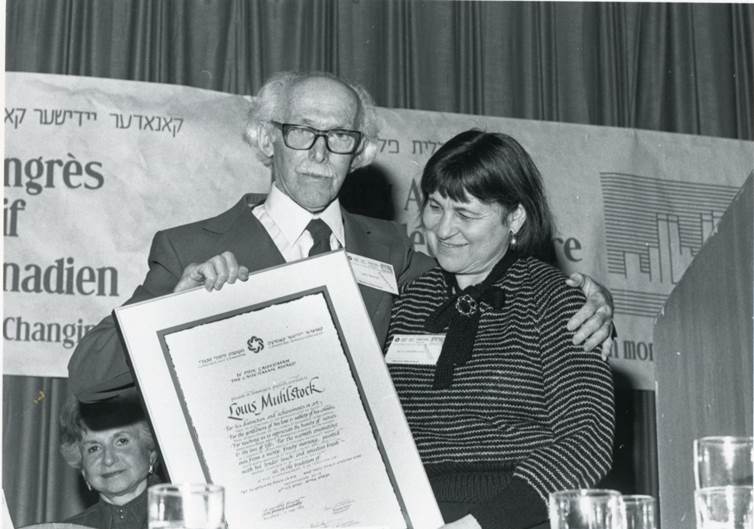 Louis Muhlstock receiving the H. M. Caiserman Award during Canadian Jewish Congress from Ghitta Caiserman-Roth, H.M. Caiserman's daughter, 1985.Photo Credit : Jewish Public Library - Archives
Louis Muhlstock receiving the H. M. Caiserman Award during Canadian Jewish Congress from Ghitta Caiserman-Roth, H.M. Caiserman's daughter, 1985.Photo Credit : Jewish Public Library - Archives -
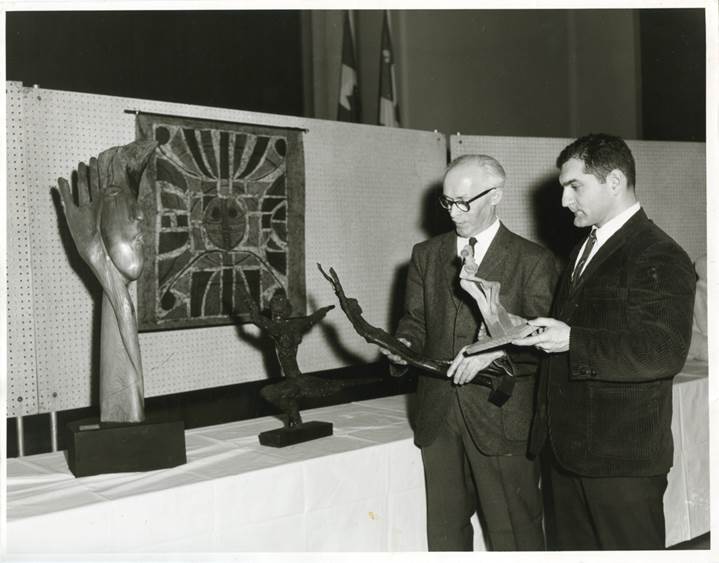 Stanley Lewis and Louis Muhlstock, Art Exhibit, Jewish General Hospital, 1967.Photo Credit : Jewish Public Library - Archives
Stanley Lewis and Louis Muhlstock, Art Exhibit, Jewish General Hospital, 1967.Photo Credit : Jewish Public Library - Archives -
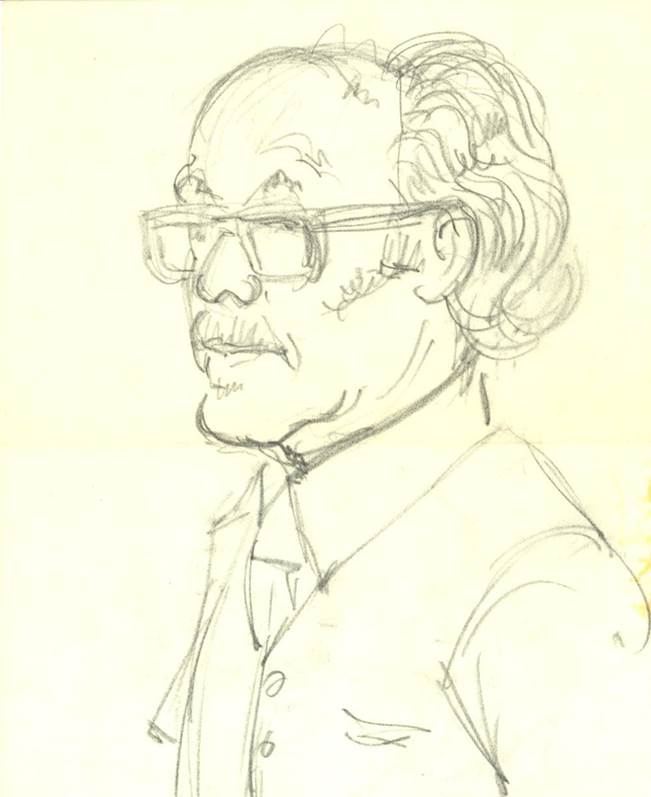 Louis Muhlstock, profile and sketch by Lou Seligson, Canadian Jewish News, 1977.Photo Credit : Alex Dworkin Canadian Jewish Archives
Louis Muhlstock, profile and sketch by Lou Seligson, Canadian Jewish News, 1977.Photo Credit : Alex Dworkin Canadian Jewish Archives -
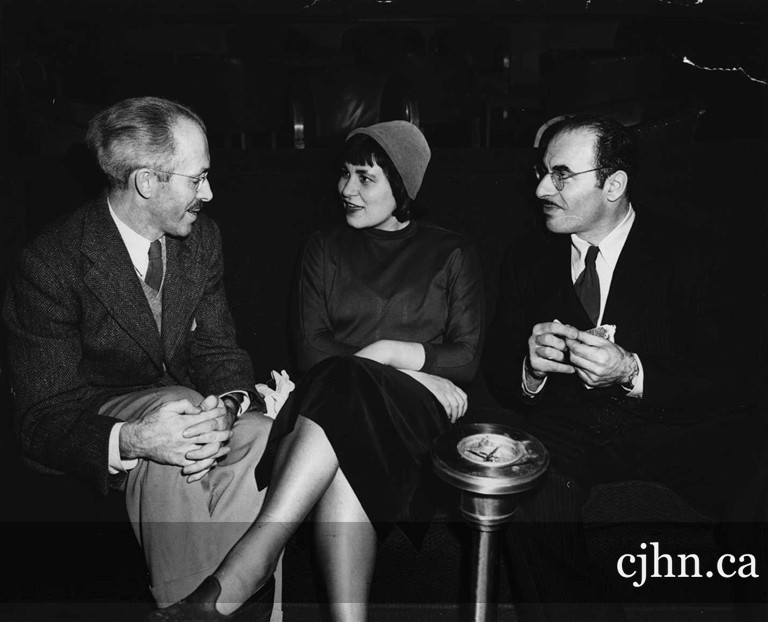 Louis Muhlstock and Ghitta Caiserman-Roth, ca. 1955.Photo Credit : Alex Dworkin Canadian Jewish Archives
Louis Muhlstock and Ghitta Caiserman-Roth, ca. 1955.Photo Credit : Alex Dworkin Canadian Jewish Archives
Louis Muhlstock
Louis Muhlstock was a renowned Canadian draughtsman and painter known for work that captured the marginalized of Depression-era Montreal.
Born in Narajow, Galicia (Austro-Hungary), Muhlstock immigrated to Montreal with his family in 1911. He studied art at the Art Association of Montreal and the Fine Arts School. His first exhibit was at the Royal Canadian Academy in 1925. He left for Paris in 1928 where, until 1931, he studied with Louis Biloul and sketched at the Grande Chaumière, the same Parisian art school where Modigliani and Jean-Paul Riopelle studied. He returned to Montreal in 1931 to become a full-time painter.
Muhlstock was renowned for his sense of humanity. He painted the poor, the destitute and even hospitalized patients. His famous work, Paranka (1932), is of a blind and terminally ill patient. Later he would paint empty rooms and abandoned buildings, symbolizing the angst of his world. In his early works, the ubiquity of the Depression is reflected in the austerity of his creations.
Muhlstock was a member of the Canadian Society of Graphic Artists, the Canadian Group of Painters, the Contemporary Arts Society, the Federation of Canadian Artists and the Canadian Society of Painters in Water Colour. He held an honorary doctorate from Concordia University (1978) and was an Officer of the Order of Canada (1991) and Knight of the Order of Quebec (1998). He was also one of the deans of the Jewish Painters of Montreal.
Learn more:
https://en.wikipedia.org/wiki/Louis_Muhlstock
https://www.gallery.ca/en/see/collections/artist.php?iartistid=3890

-
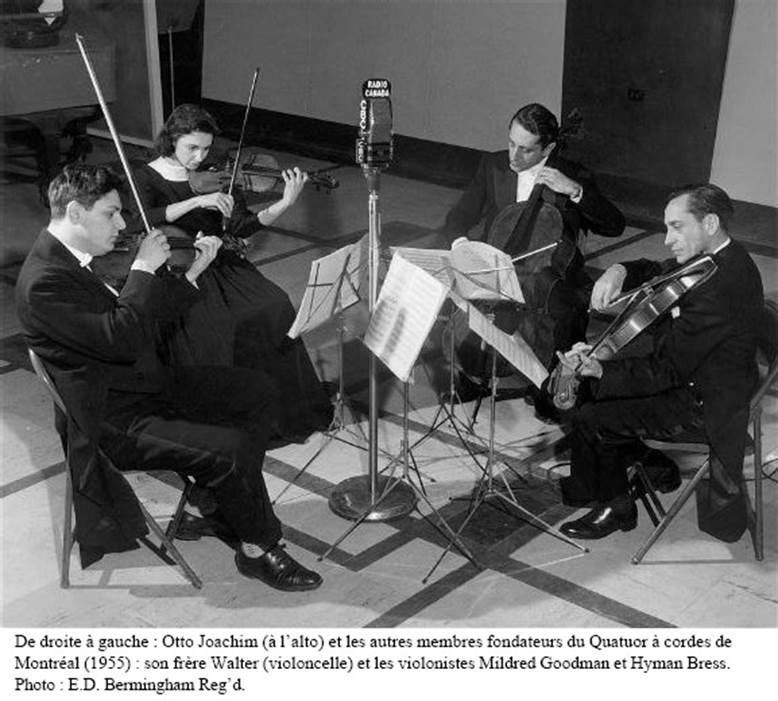 Otto and Walter Joachim at the Fondateurs du Quarters a Cordes de Montreal in 1955.Photo Credit : E.D. Bermingham Reg’d
Otto and Walter Joachim at the Fondateurs du Quarters a Cordes de Montreal in 1955.Photo Credit : E.D. Bermingham Reg’d -
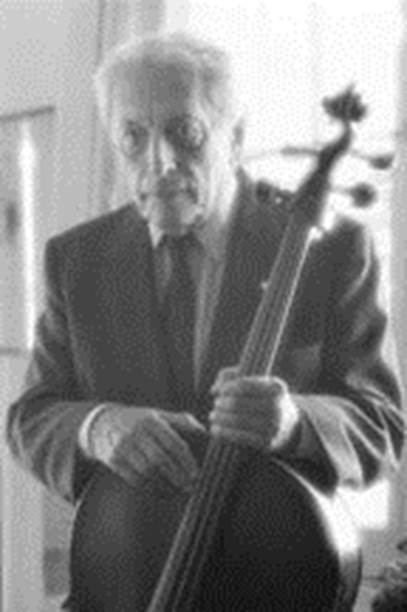 Walter Joachim in Montreal (1990s).Photo Credit : Marc-André Grenie for Les Prix du Québéc.
Walter Joachim in Montreal (1990s).Photo Credit : Marc-André Grenie for Les Prix du Québéc. -
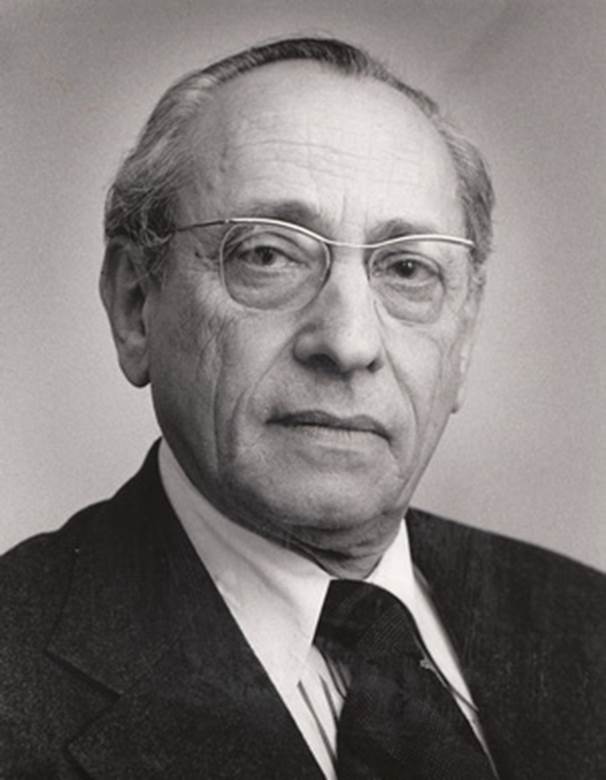 Otto Joachim.Photo Credit : The Métropolitain
Otto Joachim.Photo Credit : The Métropolitain
Otto and Walter Joachim
Otto and Walter Joachim were distinguished musicians and composers who brought their talents from Germany to Canada, where they became key figures in Montreal’s cultural sphere.
The brothers were born in Dusseldorf, and began studying violin there at an early age. In 1934, when the Nazis came to power, Otto was forced to flee Germany for Asia. He went first to Singapore and then to China – it being one of the few countries open to Jews during the war. In Shanghai, he met his wife, fellow Berliner Ellen Dieneman, and they had a son, Davis. In 1949, Otto and his family decided to move to Brazil. En route to South America via North America, however, he fell in love with the European nature of Montreal and decided to stay. Walter, meanwhile, spent the 1930s touring with a group of musicians throughout Europe and Asia, before also settling in Canada, in 1952.
During the 1950s, Otto and Walter began to make their mark on Montreal. They joined the Montreal Symphony Orchestra and the McGill Chamber Orchestra (Otto as a solo violinist and Walter as a principal cellist). They also co-founded the Montreal String Quartet. And for the Canadian Pavilion at Expo 67, Otto composed an electroacoustic piece called Katimavik.
In 1956, Otto started teaching at McGill University, and founded his own electroacoustic music research studio. He spent many years experimenting with sound and was a key player in the modernist avant-garde music movement. Walter, confronted with his progressive deterioration from Parkinson’s disease, increasingly focused on academia, teaching at schools including the CMM, McGill University and the Orford Arts Centre.
Both brothers were named Knights of the Order of Quebec (Walter in 1992, Otto in 1993). Otto was made an Honorary Member of the Canadian Electroacoustic Community, was awarded the Grand Prix Paul-Gilson and the Prix Calixa-Lavallée, was given an Honorary Doctorate from Concordia University, and was honoured with an electroacoustic studio named after him at the school. Walter was made a member of the Order of Canada and received the Denise Pelletier Prize.
Learn more:
https://en.wikipedia.org/wiki/Otto_Joachim_(composer)
http://www.scena.org/lsm/sm16-3/sm16-3_joachim_en.html
http://www.thecanadianencyclopedia.ca/en/article/walter-joachim-emc/

-
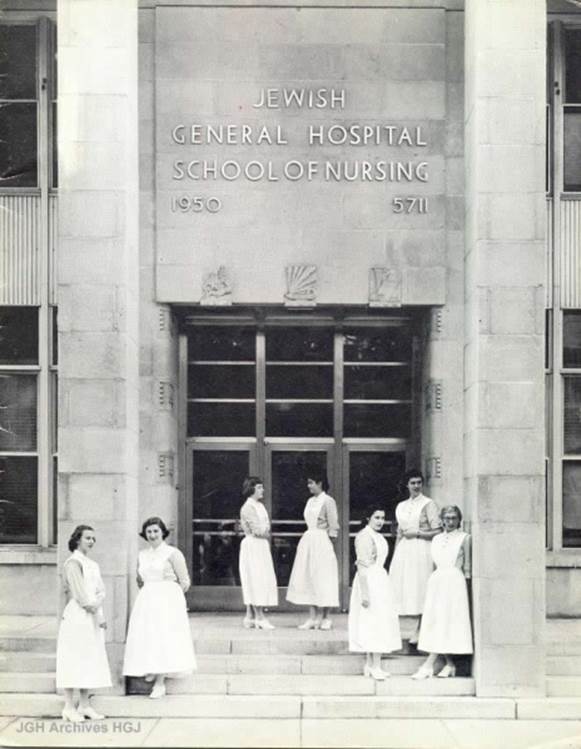 The School of Nursing opened in 1951. This photograph is from the cover of a promotional pamphlet for the new School of Nursing of the Jewish General Hospital.Photo Credit : © JGH Archives HGJ
The School of Nursing opened in 1951. This photograph is from the cover of a promotional pamphlet for the new School of Nursing of the Jewish General Hospital.Photo Credit : © JGH Archives HGJ -
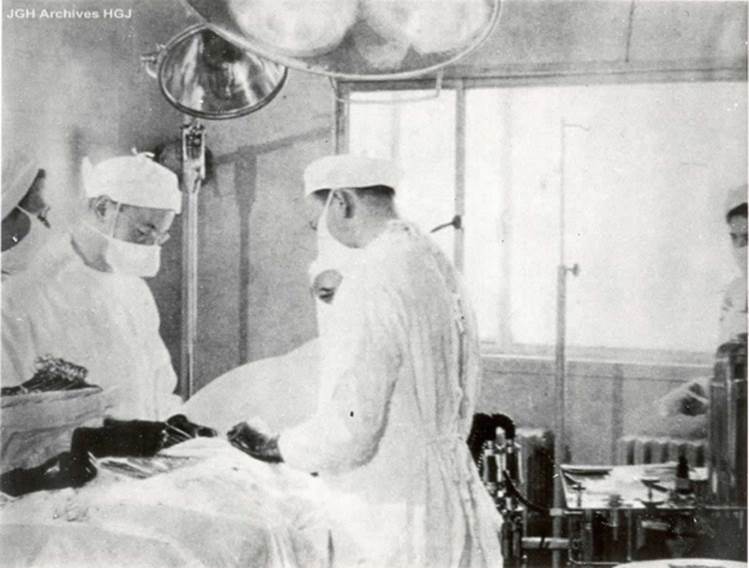 Surgeons performing surgery during the early years of the Jewish General Hospital in one of the earliest operating rooms.Photo Credit : © JGH Archives HGJ. ID 1.1-1.14.29. Reproduced with permission from the Jewish General Hospital Archives website.
Surgeons performing surgery during the early years of the Jewish General Hospital in one of the earliest operating rooms.Photo Credit : © JGH Archives HGJ. ID 1.1-1.14.29. Reproduced with permission from the Jewish General Hospital Archives website. -
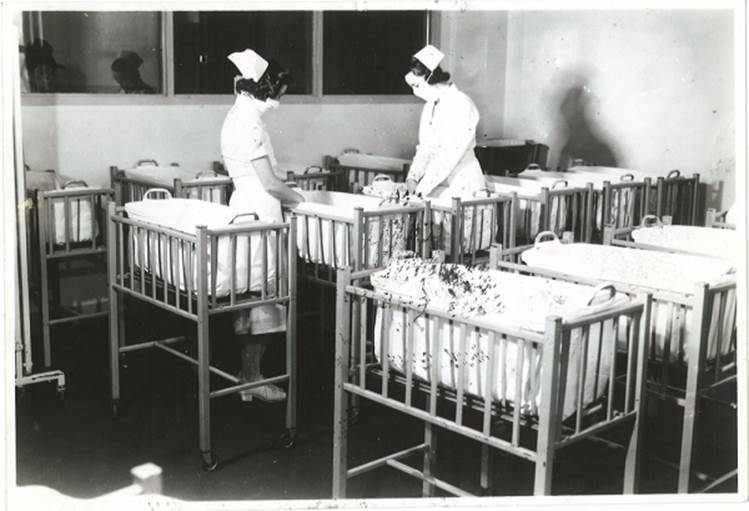 Interior shot of nursery, two nurses in masks tending to babies, Jewish General Hospital, Montreal, ca. 1950s.Photo Credit : Jewish Public Library Archives
Interior shot of nursery, two nurses in masks tending to babies, Jewish General Hospital, Montreal, ca. 1950s.Photo Credit : Jewish Public Library Archives -
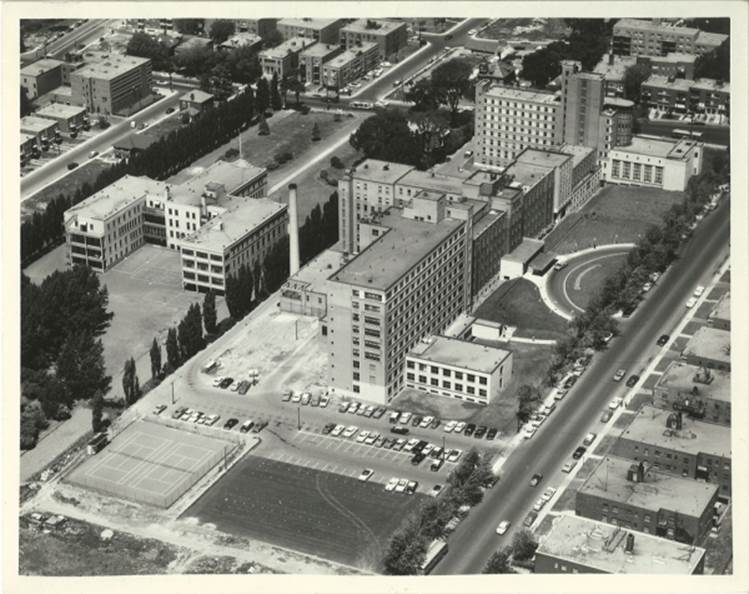 Exterior shot, aerial view of Jewish General Hospital and grounds, Montreal, ca. 1950s.Photo Credit : Jewish Public Library Archives
Exterior shot, aerial view of Jewish General Hospital and grounds, Montreal, ca. 1950s.Photo Credit : Jewish Public Library Archives -
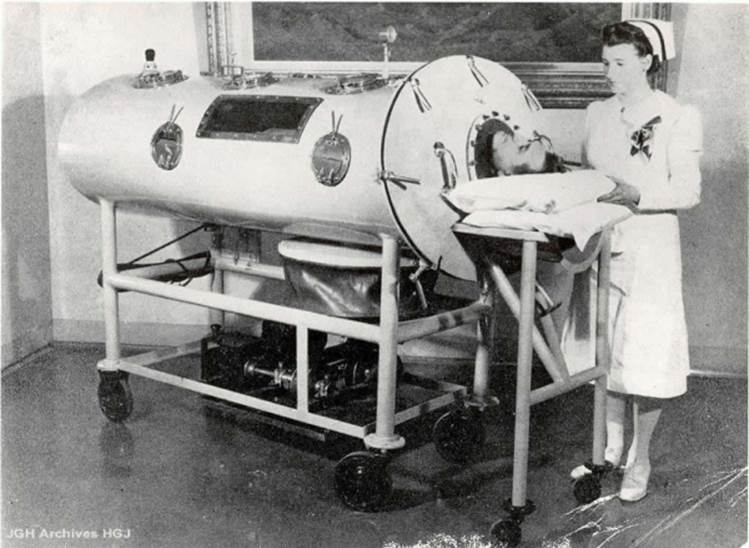 A nurse takes care of a patient who has been placed in an iron lung, a steel chamber to maintain his breathing ability, at the Jewish General Hospital, ca. 1940s or 1950s.Photo Credit : © JGH Archives HGJ
A nurse takes care of a patient who has been placed in an iron lung, a steel chamber to maintain his breathing ability, at the Jewish General Hospital, ca. 1940s or 1950s.Photo Credit : © JGH Archives HGJ -
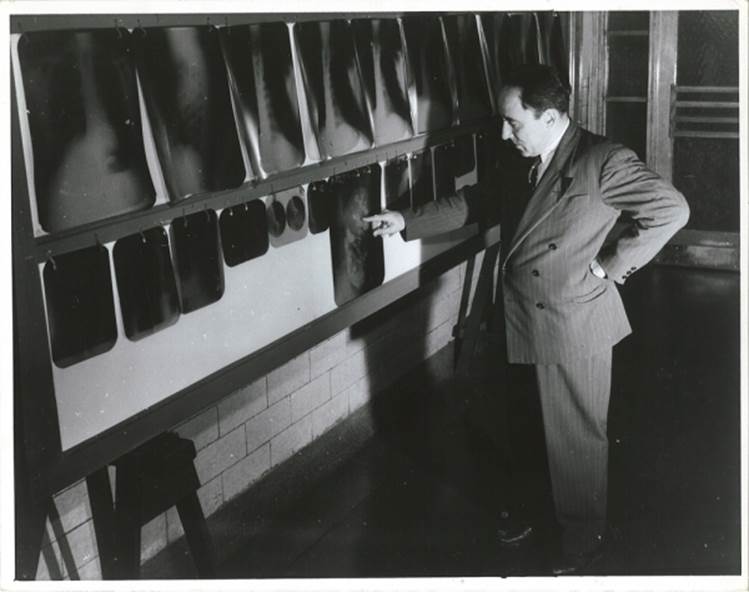 Unidentified man studying x-rays, Jewish General Hospital, Montreal, ca. 1940s.Photo Credit : Jewish Public Library Archives
Unidentified man studying x-rays, Jewish General Hospital, Montreal, ca. 1940s.Photo Credit : Jewish Public Library Archives -
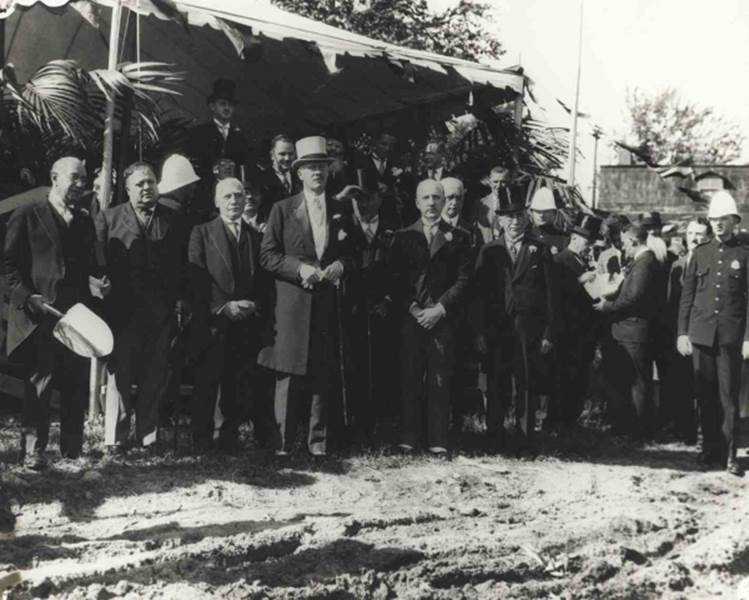 Group portrait of men, including Horace Cohen, Allan Bronfman, Rabbi Herman Abramowitz, Governor General Earl Bessborough, and Joseph Levinson Sr., standing outside next to tent, at Turning of Sod Ceremony, Jewish General Hospital, Montreal, 1931.Photo Credit : Alex Dworkin Canadian Jewish Archives
Group portrait of men, including Horace Cohen, Allan Bronfman, Rabbi Herman Abramowitz, Governor General Earl Bessborough, and Joseph Levinson Sr., standing outside next to tent, at Turning of Sod Ceremony, Jewish General Hospital, Montreal, 1931.Photo Credit : Alex Dworkin Canadian Jewish Archives -
 The photograph shows a special citizen's meeting with more than 3,000 people in attendance on Sept. 22, 1929 at the Mount Royal Hotel. A one million dollar campaign was inaugurated by Montreal's Jewish community to collect financial pledges and to proceed with plans to build the Jewish Hospital.Photo Credit : © JGH Archives HGJ.
The photograph shows a special citizen's meeting with more than 3,000 people in attendance on Sept. 22, 1929 at the Mount Royal Hotel. A one million dollar campaign was inaugurated by Montreal's Jewish community to collect financial pledges and to proceed with plans to build the Jewish Hospital.Photo Credit : © JGH Archives HGJ. -
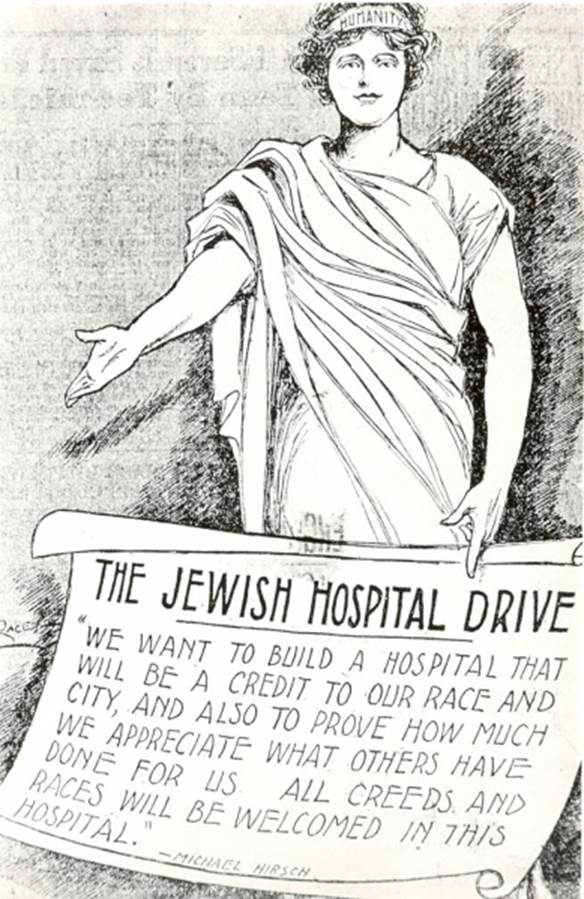 Published in the Montreal Daily Star on Sept. 23, 1929, the editorial cartoon shows a goddess, who symbolizes humanity, holding a poster on which is quoted Mr. Michael Hirsch's statement on the goal of founding the Jewish General Hospital. Mr. Hirsch was the joint chairman of the Committee of the Capital Campaign in 1929.Photo Credit : © JGH Archives HGJ.
Published in the Montreal Daily Star on Sept. 23, 1929, the editorial cartoon shows a goddess, who symbolizes humanity, holding a poster on which is quoted Mr. Michael Hirsch's statement on the goal of founding the Jewish General Hospital. Mr. Hirsch was the joint chairman of the Committee of the Capital Campaign in 1929.Photo Credit : © JGH Archives HGJ. -
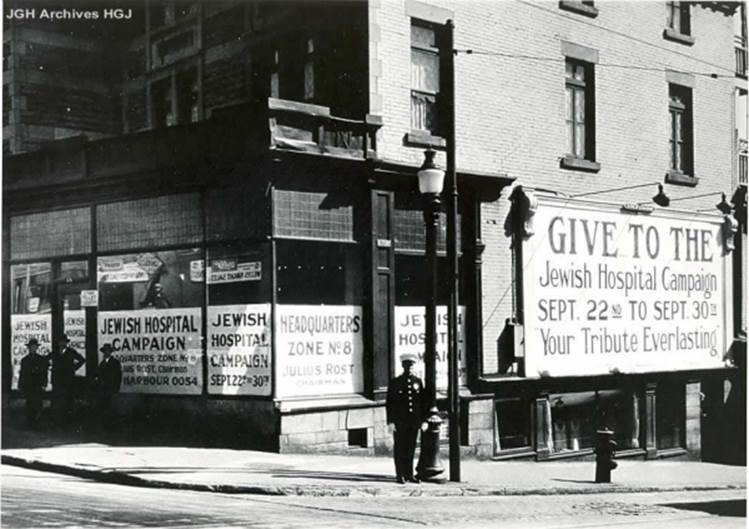 Photograph depicting capital campaign billboards set in different districts of Montreal's Jewish community raising funds for the Jewish General Hospital in 1929.Photo Credit : © JGH Archives HGJ.
Photograph depicting capital campaign billboards set in different districts of Montreal's Jewish community raising funds for the Jewish General Hospital in 1929.Photo Credit : © JGH Archives HGJ.
The Jewish General Hospital
When the Jewish General Hospital (JGH) was inaugurated in October 1934, few could have imagined that it would eventually rank among Quebec’s largest, busiest and most renowned healthcare institutions.
The story of the JGH begins in the 1880s, when many Jews began to flee the anti-Semitic persecution of Russia and Eastern Europe, and to resettle in cities across North America, including Montreal. Unfortunately, the religious discrimination that prevailed in Quebec during that era prevented Jews from receiving medical care—and from finding employment—in most of Montreal’s larger hospitals. Thus, during the 1910s and ’20s, as the Jewish population of Montreal soared from 5,000 to 20,000, health care was provided mainly by several small Jewish clinics. However, by the late 1920s, it was clear that these under-staffed and under-equipped facilities were insufficient to meet the rapidly growing need.
In search of a solution, Montreal’s Jewish leaders conducted a feasibility study and determined that proper health care could be delivered only by a modern general hospital. The proposal to build the hospital was resoundingly ratified at a mass meeting of Jewish Montrealers in September 1929.
Ironically, only a few weeks later, the task of funding the construction grew much more complicated, as a result of the crash of the U.S. stock market and the launch of the decade-long Great Depression. Nevertheless, the determination to build a Jewish hospital (with support from the provincial government) was so strong that all of the pledges—even those made by private citizens of modest means—were eventually honoured.
As the 1930s dawned, and with the launch of the JGH still several years away, the hospital’s founders decided that one of the cornerstones of the new institution would be a policy that has remained in effect ever since: an official commitment to offer health care and employment to all individuals, regardless of their religious, ethnic, cultural or linguistic background.
And so, when the JGH opened in 1934, it was among the earliest public healthcare institutions in Quebec—and possibly even the very first—to officially adopt a non sectarian, non discriminatory policy. This outstanding move was highlighted in a number of opening-day speeches, including those by Montreal Mayor Camilien Houde, a representative of the Premier of Quebec, and the Governor General of Canada, Lord Bessborough, who described the JGH as “a monument to that spirit of charity toward your fellow men, which has always been the characteristic of Jewry throughout the world.”
Since 1934, the JGH has lived up to the vision of its founders by implementing the latest technological developments in medical treatment, complemented by the sensitivity and compassion that patients need and deserve. Over the decades, the hospital has evolved into a healthcare hub in its Côte-des-Neiges neighbourhood, which is home to a large number of new immigrants from a great many countries. Although English and French are the most common languages spoken in this officially bilingual hospital, dozens of languages can be heard in the JGH over the course of a typical year.
In 2015, as part of a province-wide reorganization of the public healthcare system, the JGH was among the many healthcare and social services facilities in the west-central portion of the city that were brought together to form the Integrated Health and Social Services University Network for West-Central Montreal (also known as CIUSSS West-Central Montreal).
The hospital’s most significant modern milestone was the opening in early 2016 of Pavilion K, the largest, most complex and most ambitious expansion project in the history of the JGH. This large critical-care wing now houses the Emergency Department, Adult Intensive Care, Neonatal Intensive Care, Coronary Care, the Family Birthing Centre, the operating rooms and many other units and services.
Today, as a McGill University teaching hospital, the JGH is the site of one of Quebec’s top comprehensive cancer centres (the Segal Cancer Centre), and of one of Canada’s leading research facilities (the Lady Davis Institute). With a staff of more than 5,100 (including nearly 700 attending doctors and over 1,600 nurses), the JGH annually handles more than 700,000 outpatient visits, over 84,000 emergency visits, nearly 12,000 surgical procedures, and the delivery of approximately 3,700 babies. In addition, it benefits from the activities of at least 1,000 volunteers.
Text compiled by the CIUSSS West-Central Montreal
Learn more:

-
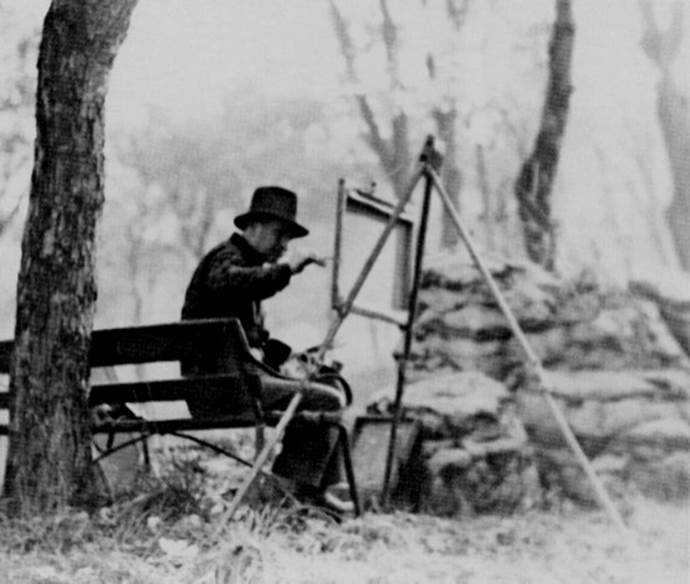 Borenstein painting on Mount Royal, 1948.Photo Credit : Tansky’s Phone Booth
Borenstein painting on Mount Royal, 1948.Photo Credit : Tansky’s Phone Booth -
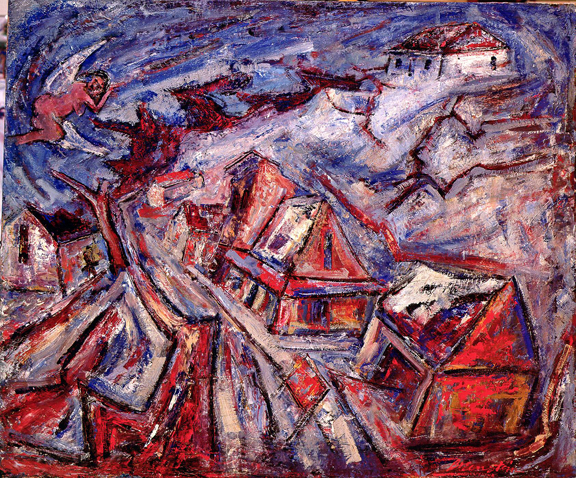 Sam Borenstein, Composition in red and blue, 1944, oil on canvas, 107x72 cm.Photo Credit : © Borenstein Estate
Sam Borenstein, Composition in red and blue, 1944, oil on canvas, 107x72 cm.Photo Credit : © Borenstein Estate -
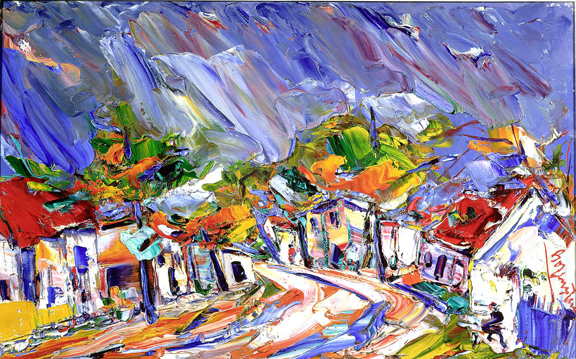 Sam Borenstein, Ste. rose quebec, 1956, oil on canvas, 51x81 cm.Photo Credit : © Borenstein Estate
Sam Borenstein, Ste. rose quebec, 1956, oil on canvas, 51x81 cm.Photo Credit : © Borenstein Estate -
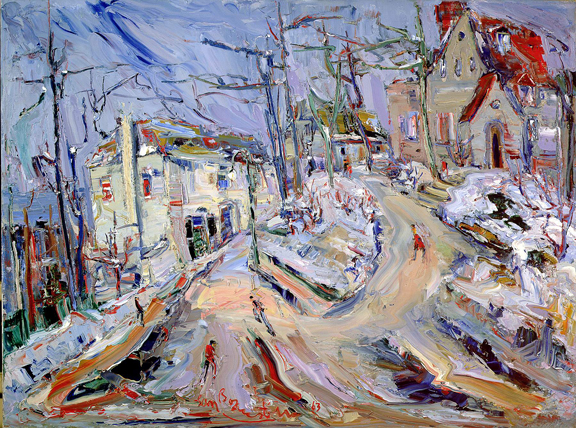 Sam Borenstein, Streetscene in Westmount, 1963, oil on canvas, 76x102 cm.Photo Credit : © Borenstein Estate
Sam Borenstein, Streetscene in Westmount, 1963, oil on canvas, 76x102 cm.Photo Credit : © Borenstein Estate
Sam Borenstein
Sam Borenstein, one of the Jewish Painters of Montreal, was a renowned Canadian artist.
Born in Lithuania, Borenstein immigrated to Montreal in 1921 with his father and one sister. He first worked as a furrier’s apprentice in Ottawa before returning to Montreal, where he found employment in the garment industry. He took evening classes in drawing and sculpture.
Borenstein’s expressionist style was inspired by masters such as Chaim Soutine and Vincent Van Gogh. He began exhibiting in Montreal in 1934. His first subject was Depression-era Montreal, which he depicted with great energy and bright colours. In 1939, he travelled to Brittany, and was able to see the works of his mentors. From that point on, his painting became more focused. In the 1940s, he travelled to the Laurentian Mountains, where he painted many of his most well-known works. Although acclaimed for his colourful landscapes, full of movement and energy, Borenstein also painted portraits.
Since the 1960s, many of his works have been shown at the Galerie L’Art français. In 2005, he was the subject of an exhibit at the Montreal Museum of Fine Arts. In 1992, he was the subject of a documentary directed by his daughter, called The Colours of My Father.
Learn more:
https://en.wikipedia.org/wiki/Sam_Borenstein
http://www.klinkhoff.ca/artist-sam-borenstein-paintings
http://www.gallery.ca/cybermuse/enthusiast/thirties/artist_e.jsp?iartistid=601

-
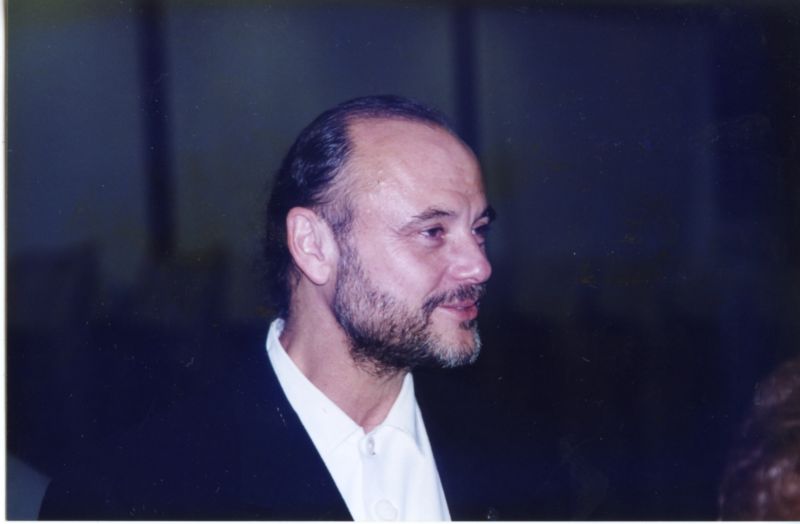 Moses Znaimer, 1977.Photo Credit : Jewish Public Library - Archives
Moses Znaimer, 1977.Photo Credit : Jewish Public Library - Archives -
 MusiquePlus, a popular music-television station in Quebec, was founded by Znaimer in 1986.Photo Credit : Musiqueplus
MusiquePlus, a popular music-television station in Quebec, was founded by Znaimer in 1986.Photo Credit : Musiqueplus
Moses Znaimer
Moses Znaimer is a Canadian media mogul and current head of ZoomerMedia who, amongst other ventures, founded both the MuchMusic and MusiquePlus television channels.
Born in Tajikstan to Latvian and Polish refugees of World War Two, Znaimer arrived in Montreal in 1948 after a stay in a Displaced Persons Camp in Germany. He graduated from McGill University with a BA in Philosophy and Politics and from Harvard University with an MA in Government. While at McGill, he served as President of the McGill Debating Union.
Znaimer’s career in broadcasting began when he joined the Canadian Broadcasting Corporation (CBC) in the mid-1960s. Known for such shows as Cross Country Checkup, as well as Take 30 with Adrienne Clarkson, Znaimer left CBC and entered into private broadcasting.
In 1972, Znaimer and a partner launched Citytv, pioneering a casual and contemporary broadcasting style aimed at youth. In 1981, Toronto-based media conglomerate CHUM Limited purchased Citytv, and Znaimer became Vice President of CHUM and Executive Producer for all of Citytv’s programming. By 1984, Znaimer and John Martin’s vision of a 24-hour music video station was realized with the creation of MuchMusic. MusiquePlus, a joint venture based in Montreal and catering to Canada’s French-speaking audiences, was launched in 1986. Znaimer’s company also launched channels such as Bravo! (1995), Space (1997), the first 24-hour local news station, CablePulse 24 (1998), Canadian Learning Television, Star!, Drive-In Classics, Fashion Television, BookTelevision, CourtTV Canada, SexTV: The Channel, MuchLOUD and MuchVibe. Although he resigned in 2003, he reappeared in 2005 and created a new media empire, ZoomerMedia.
Znaimer’s contributions to Canadian culture have been recognized with a Governor General’s Performing Arts Award for Lifetime Artistic Achievement and the Order of Ontario.
Learn more:
https://en.wikipedia.org/wiki/Moses_Znaimer
http://www.mosesznaimer.com/
http://www.huffingtonpost.ca/2015/10/18/moses-znaimer-elder-care-canada_n_8314574.html
http://www.blogto.com/city/2012/09/that_time_when_citytv_was_the_street/
https://www.youtube.com/watch?v=WKvs5fyRKu4
https://www.youtube.com/watch?v=jFqQcbV-3e0

-
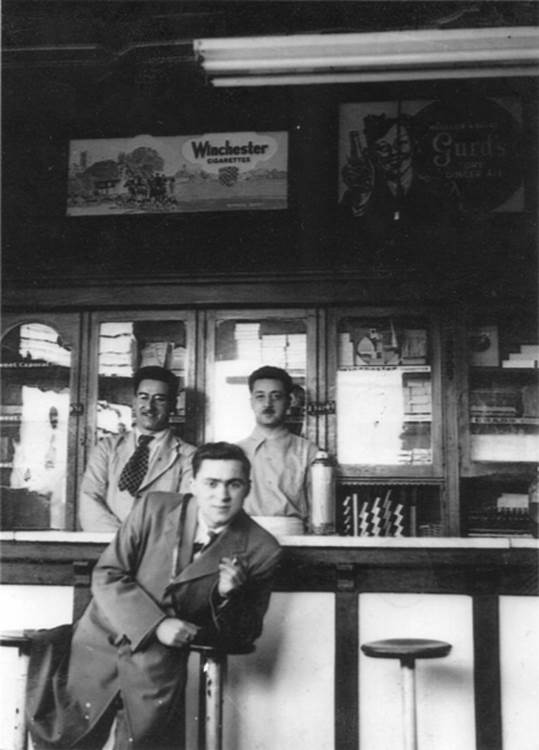 Moe Wilensky on right. His brother Archie on left. With customer, ca. 1932.Photo Credit : The Wilensky family
Moe Wilensky on right. His brother Archie on left. With customer, ca. 1932.Photo Credit : The Wilensky family -
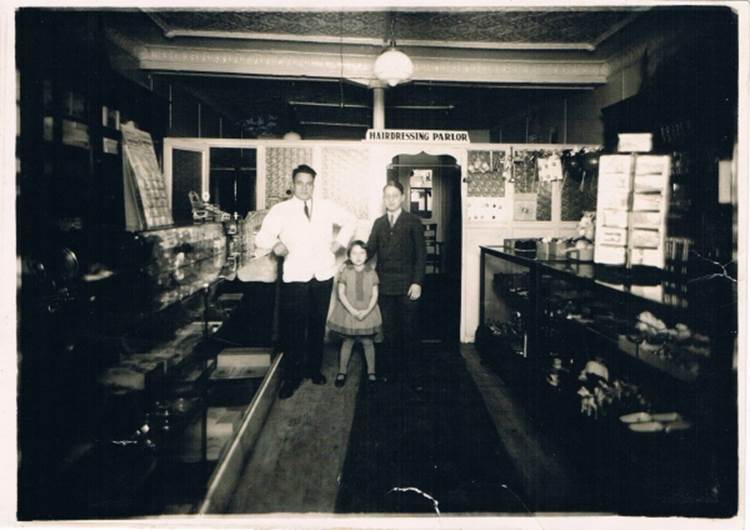 Harry, father, with Moe and Sylvia Wilensky in Harry's tobacco and barber shop at 4159 St. Laurent ca. mid 1920s.Photo Credit : The Wilensky family
Harry, father, with Moe and Sylvia Wilensky in Harry's tobacco and barber shop at 4159 St. Laurent ca. mid 1920s.Photo Credit : The Wilensky family -
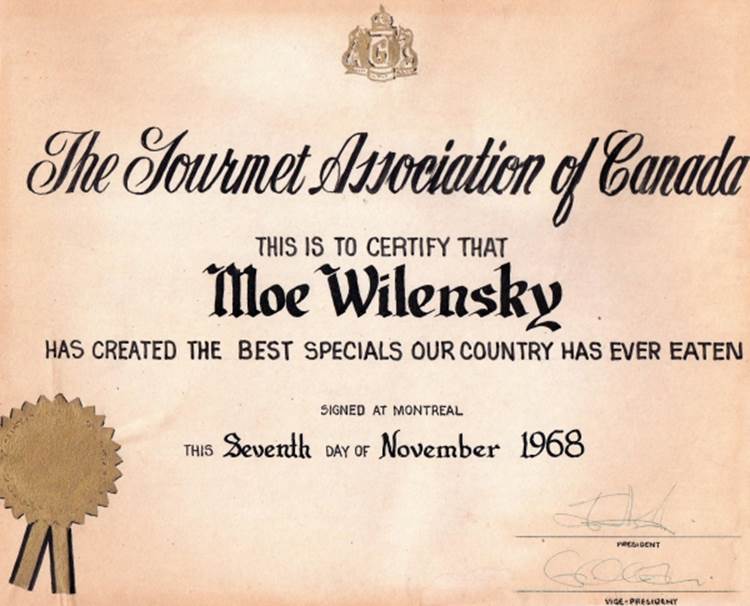 The Gourmet Association of Canada Certificate, 1968.Photo Credit : The Wilensky family
The Gourmet Association of Canada Certificate, 1968.Photo Credit : The Wilensky family -
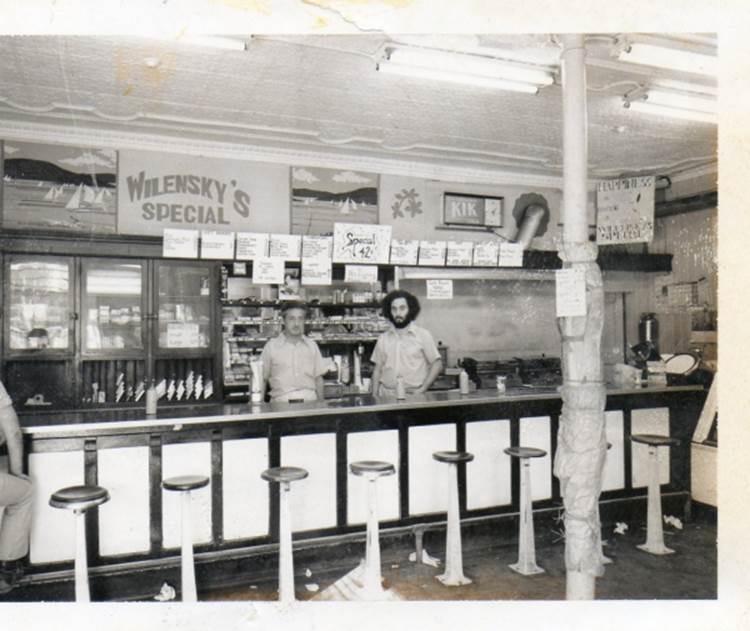 Moe Wilensky with second son Bernard in 1972.Photo Credit : The Wilensky family
Moe Wilensky with second son Bernard in 1972.Photo Credit : The Wilensky family -
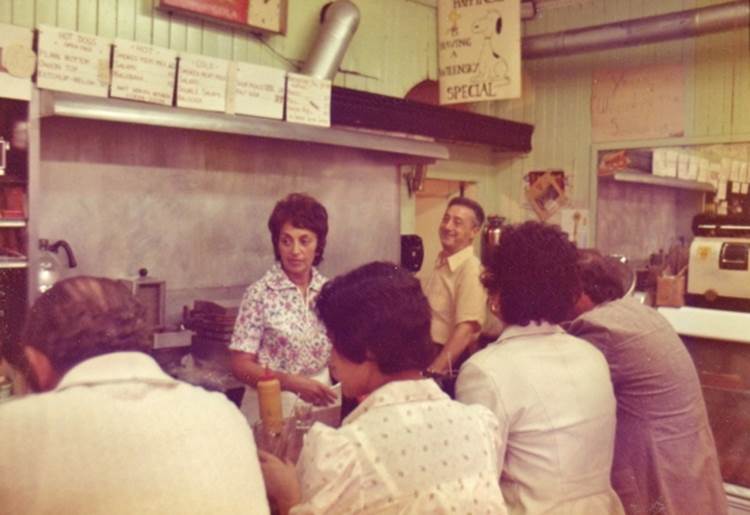 Ruth and Moe Wilensky in the mid-1970s.Photo Credit : The Wilensky family.
Ruth and Moe Wilensky in the mid-1970s.Photo Credit : The Wilensky family.
Wilensky’s Light Lunch
Founded by Moe Wilensky in 1932, Wilensky’s Light Lunch is one of the last bastions of Eastern European Jewish culture in the Mile End – a restaurant famous for its “Wilensky’s Special,” a fried salami and bologna sandwich served with mustard on a pressed roll.
Harry Wilensky, Moe’s father, emigrated from Russia to Montreal around the turn of the 20th century, along with many other Eastern European Jews. Wilensky opened a small barbershop and variety store that relocated several times following the “downtowner” Jewish community as it moved north along the Main. Harry’s sons Moe and Archie joined the family business and Moe convinced his father to start selling sandwiches.
The shop moved to 119 Fairmount O. in 1932, to the corner of Fairmount and St-Urbain in 1935, and to its present location, at the corner of Fairmount and Clark, in 1952. Not much has changed since then, not even the food or the decor.
Wilensky’s was immortalized by Mordecai Richler, a regular at the diner when he was young, as Moe’s Cigar Store in The Apprenticeship of Duddy Kravitz. Several scenes for the novel’s film adaptation were also shot on site at Wilensky’s.
The restaurant is a Jewish Montreal landmark, evoking a time when the city’s immigrant Jewish population lived mostly in the Mile End, subsisting thanks to countless small businesses such as Moe Wilensky’s. In the early 20th century, Mile End eateries also provided many Montrealers with their first exposure to Jewish culture.
Special thanks to the Museum of Jewish Montreal.
Learn more:
http://imjm.ca/location/1471
http://blogs.villagevoice.com/forkintheroad/2010/11/wilenskys_light.php
http://www.cbc.ca/archives/categories/arts-entertainment/literature/mordecai-richler-was-here/richlers-homecoming.html
http://top2000.ca/wilenskys/index.htm
http://www.canada.com/montrealgazette/columnists/story.html?id=258acefe-3252-4915-a852-ed3ec0d3b778
https://web.archive.org/web/20070629062340/http://www.mcgilldaily.com:80/view.php?aid=1360
http://www.themainmtl.com/2015/07/wilenskys-light-lunch-montreal/
https://www.youtube.com/watch?v=cek6rK5F4EA

-
 Yuli Turovsky leading the I Musici De Montreal Chamber (2000s).Photo Credit : I Musici de Montréal
Yuli Turovsky leading the I Musici De Montreal Chamber (2000s).Photo Credit : I Musici de Montréal
Yuli Turovsky
Yuli Turovsky was an acclaimed Soviet-born Canadian cellist, conductor and music educator who founded and directed the I Musici de Montréal Chamber Orchestra.
Turovsky was born in Moscow, in the former Soviet Union. At seven, he began playing the cello at the Moscow Central Music School, and then attended the Moscow Conservatory (1957-1969). He became a rising star in the Soviet classical music scene, winning first prize in the USSR Cello Competition and second prize at the Prague Spring International Music Festival. He went on to become lead cello for the Moscow Chamber Orchestra.
In the 1970s, Turovsky and his family settled in Montreal. There, he founded the I Musici de Montréal Chamber Orchestra (1983), which became one of the best known classical ensembles in Canada. Turovsky’s wife, Eleanora, was principal violin of the string orchestra from its founding until 2011, and he directed and conducted it until his death in 2013, from Parkinson’s disease.
Over the course of his career, Turovsky produced over 30 recordings. He toured internationally as a soloist, with the Borodin Trio, and with his string orchestra. He also taught at the Quebec Music Conservatory in Montreal (1977- 1985) and at UQAM (1979-until the early 2010s).
Turovsky was named a Knight of the National Order of Quebec (2010) and an Officer of the Order of Canada (2012), and he received the 2012 lifetime achievement award from the Quebec Music Council (Prix Opus).
Learn more:
http://quebecscene.ca/fr/events/eventdetails.asp?eventid=200
http://snipview.com/q/soviet_emigrants_to_canada
http://imusici.com/en/hommage-a-yuli-turovsky/
https://en.wikipedia.org/wiki/Yuli_Turovsky
http://www.thecanadianencyclopedia.ca/en/article/yuli-turovsky-emc/
http://www.thestrad.com/cellist-and-conductor-yuli-turovsky-dies/
http://imusici.com/en/orchestre/l-orchestre-de-chambre/fondateur/
http://www.bach-cantatas.com/Bio/Turovsky-Yuli.htm
http://www.cbc.ca/news/entertainment/montreal-cellist-yuli-turovsky-dies-at-73-1.1409698
http://www.lapresse.ca/arts/musique/201301/15/01-4611522-deces-du-violoncelliste-et-chef-dorchestre-yuli-turovsky.php

-
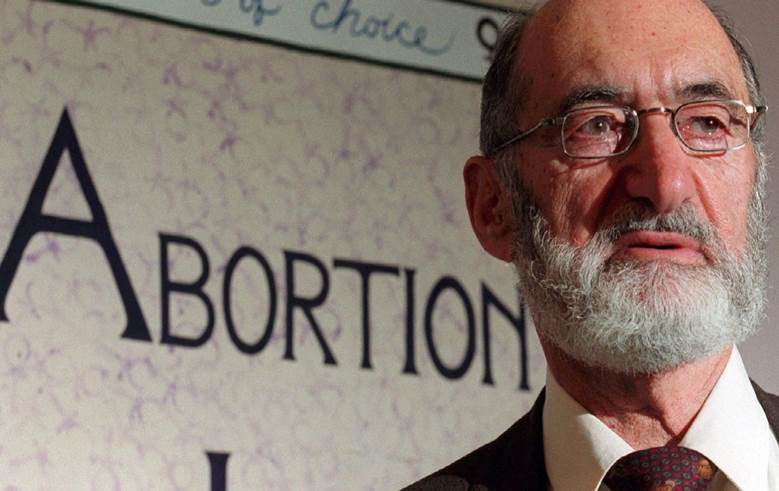 Dr. Henry Morgetaler speaks at press conference in Toronto in 1998 to mark the ten-year anniversary of the Supreme Court of Canada's decision to decriminalize abortion.Photo Credit : Canadian Press
Dr. Henry Morgetaler speaks at press conference in Toronto in 1998 to mark the ten-year anniversary of the Supreme Court of Canada's decision to decriminalize abortion.Photo Credit : Canadian Press -
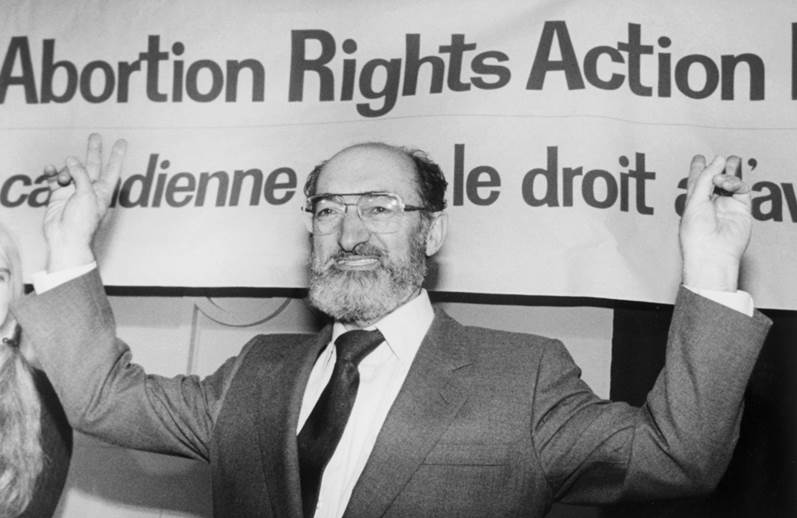 Dr. Henry Morgentaler raises his arms in victory at a news conference in Toronto, Ontario, Jan. 28, 1988.Photo Credit : Canadian Press
Dr. Henry Morgentaler raises his arms in victory at a news conference in Toronto, Ontario, Jan. 28, 1988.Photo Credit : Canadian Press
Henry Morgentaler
Henry Morgentaler was a Lodz-born physician, who held the Order of Canada for his fight for legalized abortion.
A survivor of the Lodz Ghetto and Dachau concentration camps, Morgentaler survived the war with his brother but lost both his parents to the Nazis. Morgentaler arrived in Montreal in 1950 with his writer wife, Chava Rosenfarb, to study medicine at the Université de Montréal.
In 1967, he delivered his famous brief to the House of Commons Welfare Committee stating that women in Canada should have the right to end their pregnancies without risking their lives, as heretofore, the only available abortions – illegal ones – were often risky. Realizing how great a need there was for safe abortions in Canada, Morgentaler founded his eponymously named Montreal Clinic in east-end Montreal in 1969, the first independent clinic to offer abortions to women in Canada.
Although a limited and specific number of abortions became legal in 1969, Morgentaler’s were not, since he did not demand medical prerequisites for his patients. His clinic was raided multiple times, and he was charged just as frequently. His legal battles were so lengthy and legendary – including multiple arrests, dozens of charges, a 10-month prison stint at Montreal’s Bordeaux jail during which he suffered a mild heart attack, and three jury acquittals in Quebec – that the Canadian Parliament enacted the Morgentaler Amendment, stating that no person can have a jury acquittal overturned by an Appeals court.
Morgentaler was raised within the social milieu of the Jewish Bund of prewar Poland, a secular, socialist and Yiddish cultural environment, which he credits with his commitment to human rights. He was a long-time member and president of the Canadian Humanist Association and its lifetime honorary president, and was named Humanist of the Year by the American Humanist Association in 1975.
Dogged by protests, death threats and violence over the decades, even his nomination to the Order of Canada in 2008 was controversial.
Learn more:
http://www.morgentaler25years.ca/about-henry-morgentaler/
https://www.youtube.com/watch?v=T7e0j7BFKoo
https://www.youtube.com/watch?v=QHAMael4uGY
http://o.canada.com/news/new-brunswick-pro-choice-group-raises-100000-to-save-morgentaler-clinic
http://www.ctvnews.ca/health/health-headlines/controversial-abortion-crusader-dr-henry-morgentaler-dies-at-90-1.1302143
https://www.thestar.com/news/canada/2013/05/29/henry_morgentaler_abortion_crusader_dead_at_90.html
http://news.nationalpost.com/news/canada/henry-morgentaler-hailed-as-a-true-canadian-hero-and-the-cause-of-unbelievable-damage
http://thechronicleherald.ca/canada/1131986-in-pictures-dr-henry-morgentaler-over-the-years

-
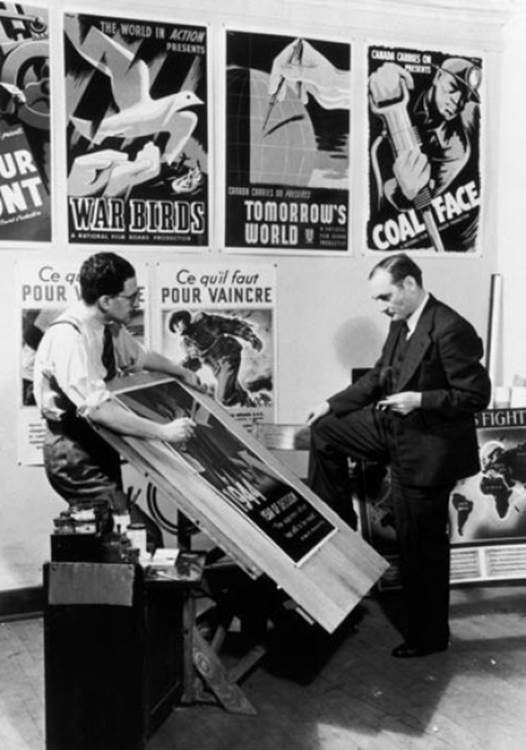 John Grierson (right), National Film Board Commissioner, and Harry Mayerovitch, director of the Wartime Information Board’s Graphic Arts Division, examine posters in 1944.Photo Credit : National Film Board
John Grierson (right), National Film Board Commissioner, and Harry Mayerovitch, director of the Wartime Information Board’s Graphic Arts Division, examine posters in 1944.Photo Credit : National Film Board -
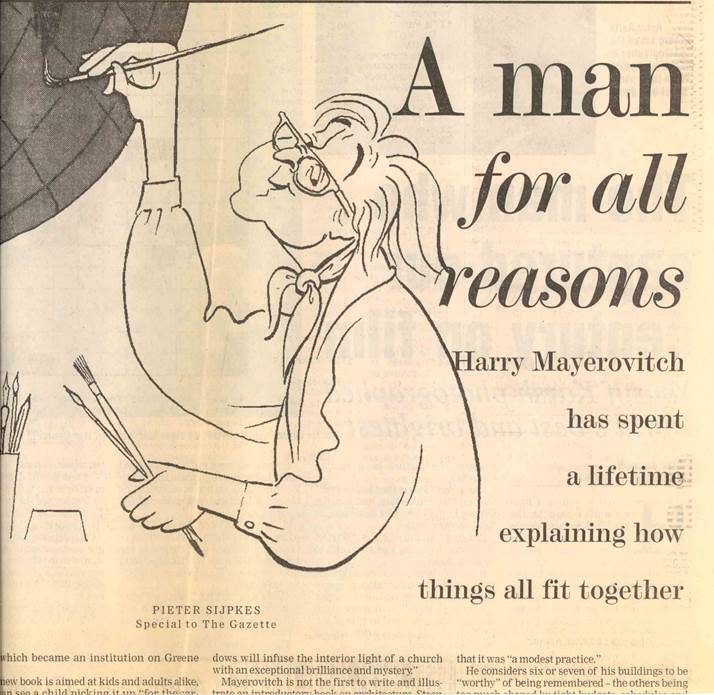 Newspaper clipping about Harry Mayerovitch in the Montreal Gazette, 1976.Photo Credit : Alex Dworkin Canadian Jewish Archives
Newspaper clipping about Harry Mayerovitch in the Montreal Gazette, 1976.Photo Credit : Alex Dworkin Canadian Jewish Archives -
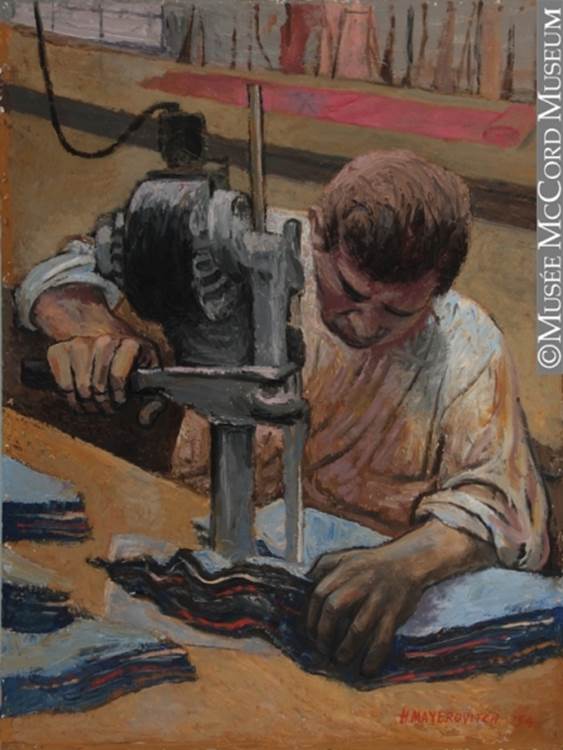 The Cutter, Harry Mayerovitch, 1954, Oil on masonite, 61 x 45.8 cm. Gift of Ms. Julie Dorsey, Mr. David Mayerovitch, Ms. Nina Mayerovitch Picton, Mr. Robert Mayerovitch. M2010.62.3Photo Credit : © McCord Museum, Montréal
The Cutter, Harry Mayerovitch, 1954, Oil on masonite, 61 x 45.8 cm. Gift of Ms. Julie Dorsey, Mr. David Mayerovitch, Ms. Nina Mayerovitch Picton, Mr. Robert Mayerovitch. M2010.62.3Photo Credit : © McCord Museum, Montréal -
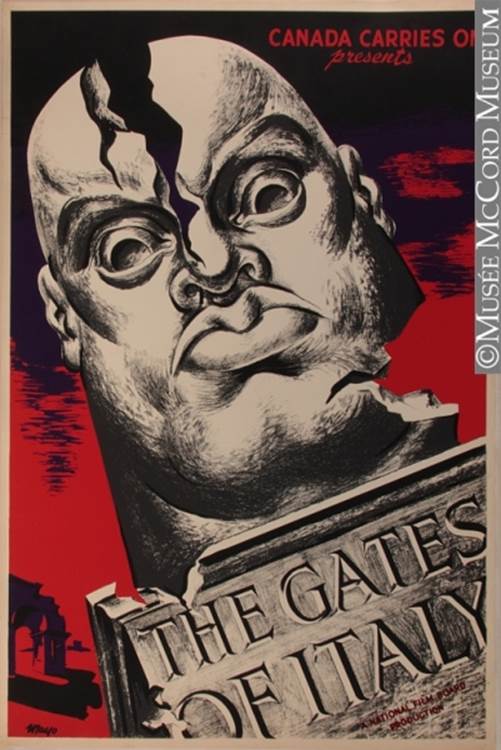 The Gates of Italy, Harry Mayerovitch, 1943, Coloured ink on paper - Serigraphy, 106.8 x 71.4 cm. Gift of Ms. Julie Dorsey, Mr. David Mayerovitch, Ms. Nina Mayerovitch Picton, Mr. Robert Mayerovitch. M2010.62.13 © McCord MuseumPhoto Credit : © McCord Museum, Montréal
The Gates of Italy, Harry Mayerovitch, 1943, Coloured ink on paper - Serigraphy, 106.8 x 71.4 cm. Gift of Ms. Julie Dorsey, Mr. David Mayerovitch, Ms. Nina Mayerovitch Picton, Mr. Robert Mayerovitch. M2010.62.13 © McCord MuseumPhoto Credit : © McCord Museum, Montréal -
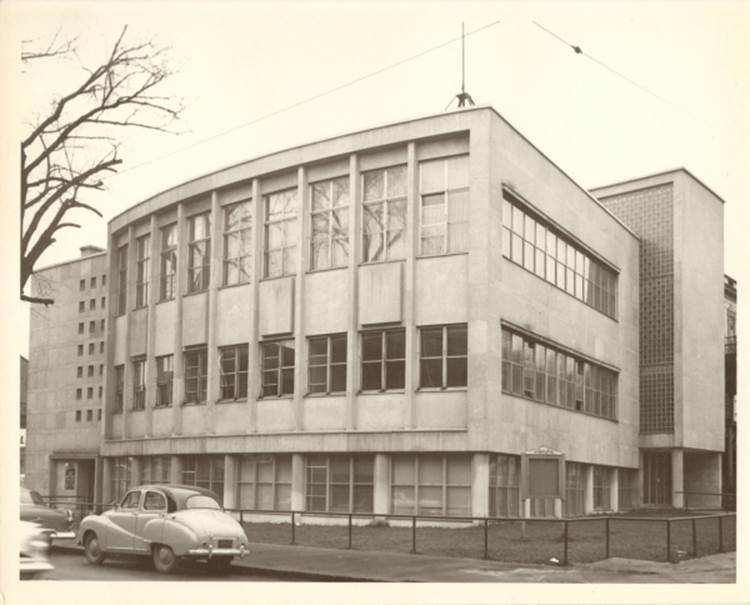 Exterior of the Jewish Public Library on Mount Royal and de l’Esplanade, ca. 1960. Designed by Harry Mayerovitch.Photo Credit : Jewish Public Library - Archives
Exterior of the Jewish Public Library on Mount Royal and de l’Esplanade, ca. 1960. Designed by Harry Mayerovitch.Photo Credit : Jewish Public Library - Archives -
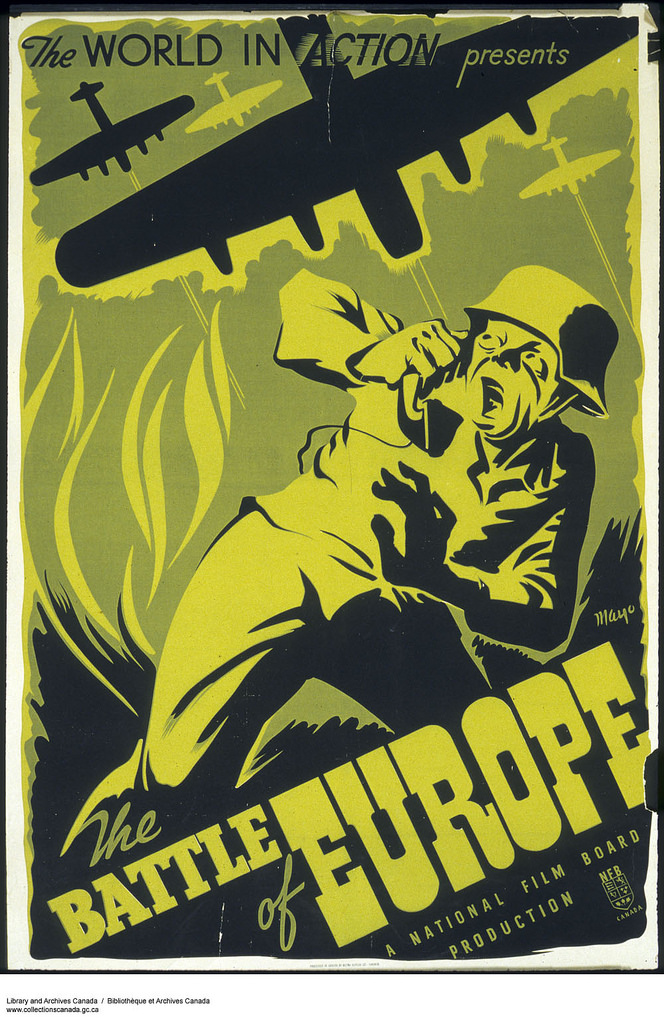 "The World in Action presents, “The Battle of Europe,” a National Film Board Production", 1944-1945.Photo Credit : Harry Mayerovitch. Library and Archives Canada, C-115706
"The World in Action presents, “The Battle of Europe,” a National Film Board Production", 1944-1945.Photo Credit : Harry Mayerovitch. Library and Archives Canada, C-115706
Harry Mayerovitch
By turns an architect, painter, creator of propaganda posters, author and accordion player, Harry Mayerovitch left a unique mark on Canada’s arts and culture landscape.
Born in Montreal to a family of Romanian Jewish immigrants, Mayerovitch grew up in the town of Rockland, Ontario. He returned to Montreal at age 15, and went on to study law at McGill University. There, he developed a passion for drawing and the arts and decided to switch gears, enrolling in the School of Architecture, from which he earned his degree in 1933.
In 1935, after working with renowned architect Percy Nobbs, Mayerovitch entered into partnership with Alan Bernstein. The buildings he designed over the course of his career include the former Jewish Library at the corner of Esplanade and Mont-Royal (now home to contemporary dance ensemble Compagnie Marie Chouinard), the Adath Israel Academy in Outremont, and the home of former Canadian Prime Minister Brian Mulroney in Westmount.
In the early 1930s, Mayerovitch travelled to Europe for the first time; the experience instilled in him a deep sense of social engagement and political awareness. Like many artists of his time, he was drawn to socialism. His Communist Party affinities led him to design propaganda posters, which garnered significant attention. He was soon recruited by the National Film Board (NFB), and appointed Director of its Wartime Information Board (1940).
During the Second World War, Mayerovitch designed numerous posters to promote the war effort and recruitment. In the following decades, he participated in an exhibition at the Montreal Museum of Fine Arts which commemorated the national bicentenary of Canadian Jewry (1995) and, for Expo 67, he served as the theme committee’s chairman of the board.
In the 1950s, he drew a regular comic strip for the Westmount Examiner. He also wrote and illustrated a dozen books, including The Other One (1973), How Architecture Speaks and Fashions our Lives (1996) and Way to Go (2004).
Special thanks to the Museum of Jewish Montreal.
Learn more:
http://imjm.ca/location/2098
https://www.mcgill.ca/architecture/memoriam/mayerovitch
http://blog.nfb.ca/blog/2015/02/25/harry-mayerovitch-nfb-propaganda-posters/
http://digital.library.mcgill.ca/warposters/english/introduction.htm

